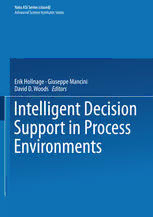Table Of ContentNato ASI Series (closed)
Advanced Science Institutes Series
Erik Hollnage · Giuseppe Mancini
David D. Woods E ditors
Intelligent Decision
Support in Process
Environments
Intelligent Decision Support inProcess Environments
NATO ASI Series
Advanced ScienceInstitutesSeries
AseriespresentingtheresultsofactivitiessponsoredbytheNATOScienceCommittee,
whichaimsatthedisseminationofadvancedscientificandtechnologicalknowledge,
withaviewtostrengtheninglinksbetweenscientificcommunities.
TheSeriesispublishedbyaninternationalboardofpublishersinconjunctionwiththe
NATOScientificAffairsDivision
ALifeSciences PlenumPublishingCorporation
BPhysics LondonandNewYork
CMathematicaland D.ReidelPublishingCompany
PhysicalSciences Dordrecht.BostonandLancaster
o
Behavioural and MartinusNijhoffPublishers
SocialSciences Boston,TheHague,DordrechtandLancaster
EAppliedSciences
F Computerand Springer-Verlag
SystemsSciences BerlinHeidelbergNewYorkTokyo
GEcologicalSciences
SeriesF:ComputerandSystemsSciencesVol.21
Intelligent Decision Support
in Process Environments
Editedby
Erik Hollnagel
ComputerResourcesInternationalA/S
Vesterbrogade1ADK-1620CopenhagenV/DENMARK
Giuseppe Mancini
CommissionofEuropeanCommunities
JointResearchCentre,IspraEstablishment
1-21020ISPRA(Varese)/ITALY
David D,Woods
WestinghouseResearch&DevelopmentCenter
BeulahRoad,Pittsburgh,PA15235/USA
Springer-Verlag Berlin Heidelberg GmbH
PublishedincooperationwithNATOScientificAffairsDivision
Proceedingsofthe NATOAdvancedStudyInstituteon IntelligentDecisionSupport in
ProcessEnvironmentsheldinSanMiniato,Italy,September16-27, 1985
IISSBBNN 997788--33--664422--5500333311--33 IISSBBNN 997788--33--664422--5500332299--00 ((eeBBooookk))
DDOOIl 1100..11000077//997788--33--664422--5500332299--00
LibraryofCongressCataloginginPublicationData.NATOAdvancecStudyInsttiuteonIntelligentDecisionSupportin
ProcessEnvironments(1985:SanMiniato,Italy)Intelligentdecisionsupportinprocessenvironments.(NATOASI
series.SeriesF,Computerandsystemsciences;vol,21)"ProceecrqsottheNATOAdvancecStudyInstituteon
IntelligentDecisionSupportinProcessEnvironmentsheld,nSanMiniato.ltaly,September16-27.1985"- Lp.verso.
1.Declsion-makin~ongresses.2.Artfiicialintelligence-Congresses.1.Hollnagel,Erik,1941-.11.Mancini.
Giuseppe,1940-.III.Woods.DavidD.,1952-IV.NorthAtlanticTreatyOrganization.ScientificAffairsDivision.V.Title.
VI.Series:NATOASIseries.SeriesF,Computerandsystemsciences,no.21.T57.95.N371985658.4'0386-6742
Thisworkissubjecttocopyright.Allrightsarereserved,whetherthewholeorpartofthematerialisconcerned
specificallythoseofIranslating.reprinting,re-useofillustrations,broadcastings,reproductionbyphotocopying
machineorsimilarmeans,andstorageindatabanks.Under§54oftheGermanCopyrightLawwherecopiesare
madeforotherthanprivateuse,afeeispayableto"VerwertungsgesellschaftWort",Munich.
©Springer-VerlagBerlinHeidelberg1986
OriginallypublishedbySpringer-VerlagBerlinHeidelbergNewYorkin1986.
2145/3140-543210
NATOADVANCEDSTUDYINSTITUTE
INTELLIGENTDECISIONSUPPORTINPROCESSENVIRONMENTS
INTELLIGENT
DECISION
SUPPORT
September16- 27,1985,SanMiniato,ltaly
Sponsoredby
DELPHI(I),IntelJiCorp(USA)
SystemsDesigners(UK),TEMA(I)
NATOScientificAffairsDivision
Preface
ThisbookcontainstheessenceofthepapersandthediscussionsfromatwoweeklongAdvanced
StudyInstitute(ASI)heldinSeptember 1985.TheideaofhavinganASIaboutthetopicofIntelligent
Decision Support (IDS)systems goes back to a NATO workshop on Human Error held at the
RockefellerCenter inBellagio,Italy,inSeptember 1983 Inawayitgoeseven furtherbacksincethe
BellagioworkshopcontinuedaseriesofNATOASlsandworkshops onadvanced human-machine
systemsthatstarted adecadeagoin1976.ThepresentASI therefore representsneitherabeginning
noranend,butisratherasnapshotofthefrontiersofthinkingaboutman-machinesystemsasthey
lookedin1985.
One problem thatwas important in 1983, and which remains so today, was to improve the
understandingof human decisionmaking and behaviour in particularly demanding applications,
suchasthecontrol ofcomplexindustrialprocesses.Onewayoftryingtosolvethisproblemwasto
organise ahigh-levelmeetingwhere therelevantdifferentscientificdisciplines couldconverge and
interact. Consequently three oftheparticipantsintheBellagioworkshop- ErikHollnagel, Giuseppe
Mancini, and David Woods, supported by a technical programme committee consisting of Don
Norman,JensRasmussen, JamesReason, andGiuseppeVolta- undertook toprepareanddirect
such a meeting. During the initial discussions the topic of themeeting was defined to be the
applicationofintelligentdecisionaidsinprocess environments, andthisinturnbecamethetitleof
theASI. TheScientificAffairsDivisionofNATOawarded agrantfortheorganisationofanAdvanced
StudyInstitute BecausethetopicoftheASI wasconsideredtobeofindustrialaswellasacademic
interest.itwasincludedintherecentlyestablishedNATODoubleJumpprogramme,whichspecifi
cally aimsat promoting cooperation between universities and industries in NATOcountries. This
permitted theASI directorstoobtainadditionalfundsfromthefollOWingfoursponsors,tosupplement
thefinancialsupportprovidedbyNATO: DELPHI(Italy),IntelliCorp (USA),SystemsDesigners(U.K.),
andTEMA (Italy). TheASIentitled'Intelligent DecisionAidsinProcess Environments' tookplace at
'ICappuccini'inSanMiniato(Italy)from 16thto27thofSeptember1985
The ASI was attended by sixty-nine participants, of which 19 were lecturers, comingfrom 14
differentcountriesandtwo internationalorganisations. ThemagnificentTuscansettingprovided an
idealbackgroundfor twoweeksofintensive,stimulatingandwide-ranging discussions.Thisbook
containsthepaperspresentedbythe19invitedlecturers,anumberofselectedshortpapers from
theparticipants,abstractsoftheothershort papers,andtheresultsofthepaneldiscussions held
duringthemeeting.Thismaterialhasbeeneditedtoreduceoverlapsandprovideaconsistentstyle.
The orderof the papershas been revisedto present thereader with a more coherent structure.
Althoughgreatcarehasbeenexercisedbytheeditors,someerrors andinconsistenCiesmaystillbe
present.Wehopethereaderwillforgivethat.Ourmaingoalhasbeentoeditandpublishthebookas
quicklyaspossiblesothatitcantrulyserveitspurposeasasnapshotofthecurrentstateofthinking.
Weexpectthatthebookwillbeofvaluetoanyonewhoisinterested intheproblemofIntelligent
decisionsupportsystemsinindustnalapplications.Wehopethatideasandperspectivespresented
here can be used by the variety of engineers, plant operators, managers, and industrial and
academicresearchersfromtherelevanttechnicalandsocialsciencedisciplinesthattodaycollabo
ratetosolvetheproblemsinadvancedprocesscontrol.
VIII
Acknowledgements.We aredeeply gratefulto theNATO Scientific Affairs Division, DELPHI,Intelli
Corp,SystemsDesigners Ltd, and TEMA forhavingsupported andfinancedtheASIon Intelligent
DecisionAidsinProcess Environments,onwhich thisbookisbased.Wearealsoverygrateful to
DonaldNorman,JensRasmussen,JamesReason,andGiuseppeVoltawhointheirroleastechnical
programmecommittee membersprovided uswith ideas, adviceand newperspectivesfromtheir
considerable experience. We further wish to thank the OECD Halden Reactor Project (Halden,
Norway),ComputerResourcesInternationalNS(Copenhagen,Denmark),theCommissionofEuro
peanCommunitiesJointResearchCentre(lspra.Italy),andtheWestinghouseResearch&Develop
mentCentre(Pittsburgh,USA)forhavingallowedustospendpartofourtimetoorganisetheASIand
edit thisbook,aswellasfortechnicaland organisationalsupport.We are, ofcourse, indebted to
those who contributed to this book; not only did they provide the 'meal' of the ASI but their
compliancewithstrictdeadlinesallowedustoproducethefinalmanuscriptinlessthansixmonths.
Special thanks arefinally due to the staff of 'ICappuccini' at San Miniatofor having offered an
exceptionallywarmenvironmentforthemeeting.
Copenhagen,December19S5 ErikHollnagel
GiuseppeMancini
DavidD.Woods
Introduction
The increasing complexityof technological systems hasshifted thedemands on human perfor
mancefrom a mechanical/physical level to a cognitive level. The role of the humanin complex
systems is to act as a supervisor of automated or semiautomated resourceswith goal setting,
problemsolving,anddecisionmakingasthe primary tasks. Whilethenegativeconsequences of
possiblemalfunctioninghave grown,thetolerances forperformance variabilityhavebeenreduced
andthedemands toaccurate andsafeperformanceincreased,therebyleavingthehumanoperator
inaverydifficultposition.Atthesametime,advancesincomputerscience(e.g.automateddecision
makers, object oriented programming, and expert systems) have provided new possibilitiesto
supporthumanperformancethatchallengeestablishedman-machinesystemdesignprinciples.
Decision making hasemerged asthefocal point fortheoften conflictingdemands to human
action. To ease the operator's task one must reduce these demands by incorporating basic
intelligence functions in the man-machine interface. Butit isessential that an intelligent interface
supportstheoperator'sdecisionmaking ratherthan replacespartsofit,i.e.thatitisatoolratherthan
a prosthesis. The former mayimprove thetask, whilethelatterwillsurely aggravate it.Thelogic
behinddecisionmaking hasbeenconsiderablyextended inrecent years,forinstancebyfuzzy-set
theoryandpossibilitytheory.Acleardistinction hasalsoemergedbetween domainspecificknowl
edge anddecisionmaking strategies.Decisionmaking is nolonger regarded assimplythestrict
following ofasingle setofrulesorastrategy,butmustalsoincludetheselection oftheappropriate
rulesandthepossibleswitchbetweenthem asthedecisionevolves,ie.metaleveldecisions.
The aimof thisASI was to identifythe knowns and unknownsof intelligent systems that can
support human decision makinginprocess environments.The focus wasthefunctionalratherthan
the analytical aspects of suchsystems. The emphasison andthedevelopment of systems that
performcognitivetasks requireacorrespondingshiftinthemultipledisciplinesthatsupporteffective
man-machinesystems.Itrequirescontributionsfrom decisiontheory, theoreticalandapplied: from
philosophyandlogic;fromprocess control theory andinformation science;from cognitivepsychol
ogy and the studyof human performance and human error; and from artificial intelligence and
computerscience. Thiswasachievedbydescribing (1)thefoundationprovided bydecisiontheory,
(2)theproblemsofdecisionmaking inprocess environments,(3)thecognitiveaspectsofdecision
making,and(4)thepossibilitiesofartificial intelligenceandadvancedcomputerapplications.TheASI
aimedtosynthesiseandintegratedevelopmentsinallfourareas.
As mentioned in thepreface,this ASIjoineda seriesofothermeetings that allhad dealt with
problemsofman-machinesystems.Thefivemajorpreviousmeetingswere:
1976 MonitoringBehaviourandSupervisoryPerformance Berchtesgaden,
WestGermany
1977 TheoryandMeasurementofMentalLoad Mati,Greece
1979 ChangesinNatureandQualityofWorkingLife Thessaloniki,Greece
1981 HumanDetectionandDiagnosisofSystemFailures Roskilde,Denmark
1983 HumanError Bellagio,Italy
x
Thepresent ASIusedtheinterdisciplinarycooperationandknowledge foundation established in
theprevious conferences toaddress theproblems ofcognitiveman-machinesystems.Duringthe
twoweeksspecialistsfrom theabove-mentioned fieldsworked togethertoadvance thesymhesis of
knowledge needed forthedevelopmentandevaluationofsuchjointcognitivesystems, presentthe
currentunsolvedproblems,andpointtopossiblesolutions.Theoutcomeisdocumentedinthisbook.
Whereas most readers of thisbook probablywill have a goodunderstanding of whatdecision
makinganddecision supportsystems are, it maybe useful todescribe brieflywhatismeantby
process environmentsandhowdecisionmakinginprocessenvironmentsdiffersfromothertypes of
decisionmaking.
Process environments arefirstof allcharacterised byhaving short time constants.Thedecision
makermustconstantly payattentiontotheprocess becausethestateofitchangesdynamically; if
he fails to do sohewilllosecontrol.Iftimewasnotthatcritical itwouldbepossible toleavethe
processandlookforinformationinotherplaces,consultavailableexpertsandknowledgebases,etc.
Touseanexamplefrom medicine,iftime isnotcriticaloneisdealingwithapopulationphenome
non,forexampletheeffectsofsmoking; iftime iscritical oneisdealingwith anindividualphenome
non, forexampletoxification. Ifthereisno time pressureonecan always refer to datafrom the
populationandneglecttheprocesswithoutendangeringit
Formaldecisiontheoriesdogenerallynotcontainanyelementoftime(cf. thepaperbyGiuseppe
Volta), hencefailtorecognise anessentialattributeofprocess environments. Theyarethereforenot
directlyapplicablebutrequirefurtherdevelopmentandmodification.
Anothercharacteristicofprocessenvironmentsistheuncertaintyaboutdata, i.e. oneisuncertain
aboutwhatthenextdatummaybe.There islessthancompletepredictabilityofwhatevidencewill
appear,bothon thelevelof individualprocess parametersandon the levelofthe process asa
whole.Theuncertaintydoesnotonlyarisefromtheimperfectionorbreakdownofsinglecomponents
asinnormal reliabilityanalysisorProbabilisticRiskAnalysis.Farmoreimportantistheuncertaintyof
the evidencethat comesfromthedynamicsand complexityoftheprocess assuch.This lackof
certaintyisinconflictwithsomeofthemainassumptionsofbothnormative anddescriptivedecision
theoryandnaturallymakesdecisionsmoredifficult(cf.thecommentsbyGeorgeApostolakis).
Processenvironmentsarefurthercharacterisedbybeingdynamic,byhavingmultipleandpossibly
conflictinggoals,andbyhaVing incompleteinformation.Thelattermayleadtotradeoffsbetweenthe
speed and quality of the decision. Decision making in process environments normally means
multipledecisionsbasedonpartialinformation,withlittlechancetoconsiderallthealternativesorto
make revisions. It is thus verydifferent from the orderly world that is assumed by conventional
decisiontheories- andprovidedbymostoftheexperimentscarriedoutinthebehavioralsciences.
ThepresentationsanddiscussionsattheAS!. aswellasthepapersinthisbook,areorganised in
foursections corresponding tothefourmainaspectsofIntelligentDecisionSupportsystems.These
are decision theory, cognitive engineering, systems engineering, and artificial intelligence. The
developmentandapplicationofIntelligentDecision Support systems mustbebasedonacombina
tionofthesefouraspects,asnoneofthem issufficientonitsown. Eachofthem referagain toother
scientific disciplines someof which, like cybernetics,arerelated toseveral aspectsof Intelligent
Decision Support. ThepresentationsanddiscussionsatthisASI clearly showed theinsufficiencyof
anyone oftheseaspects toaccountcompletelyforthefunctioning ofIntelligent Decision Support
systems, butalsodemonstrated howinterdisciplinary cooperation can bring aboutnewideasand
solutions.
Decision theory, whether normative or descriptive, is a natural starting point for this book. It
provides a basic understanding of the theoretical andpractical issues andofthecurrentlyunre
solved problems. Cognitiveengineeringgivestheviewof a recent combination of a number of
disciplinesthatallfocusonthecognitiveaspectsofsystem functioning,andinparticularaddresses
the relation between knowledge and decisionmaking. This viewis closelyrelated to the current
developments in systems engineering which, togetherwith decision theory, represent the more
established views. The section on systems engineering summarises and Identifies someof the
shortcomingsofatraditionalengineeringapproach,andpointstoways inwhich theycanbesolved.
Finally, the section on artifiCial intelligence provides the experience from trying to incorporate

